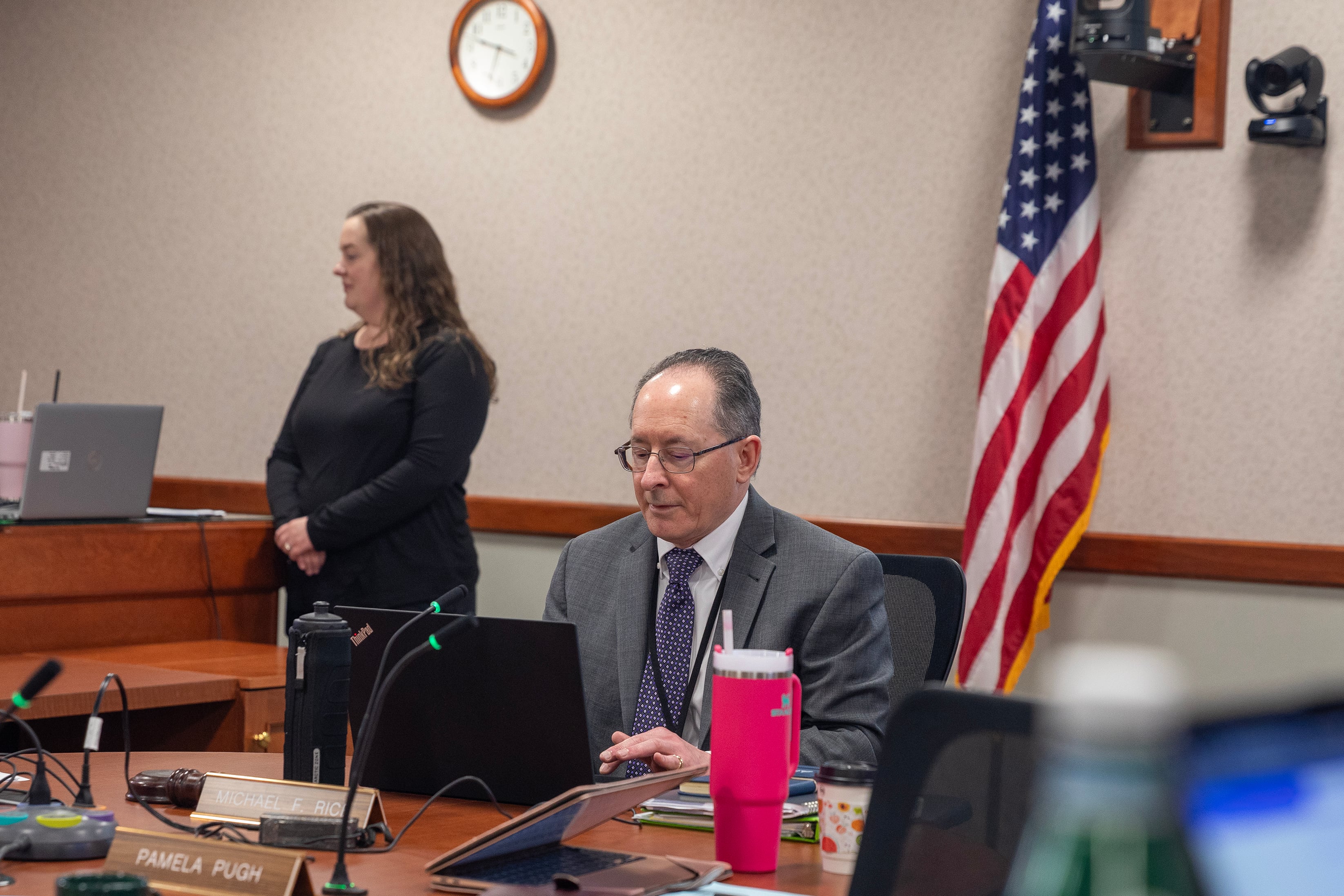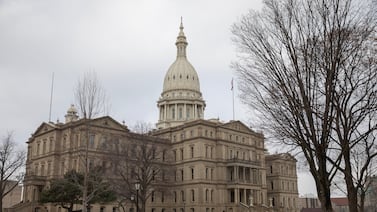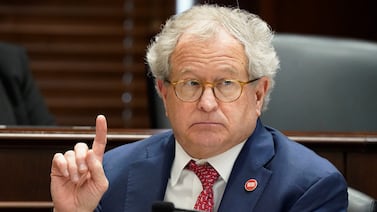Sign up for Chalkbeat Detroit’s free newsletter to keep up with the city’s public school system and Michigan education policy.
On Friday, Michigan’s State Superintendent Michael Rice closes the book on a decades-long career as an educator.
Rice, who has been the state’s top education leader since 2019, is retiring and paving the way for new leadership.
Glenn Maleyko, the current Dearborn Public Schools superintendent, takes over Dec. 8. Until Maleyko starts, Sue Carnell, the chief deputy superintendent at the Michigan Department of Education, will serve as interim state superintendent.
Rice led during a difficult time, with the pandemic upending education not even a year into his tenure. Students performed worse on state and national exams, chronic absenteeism surged, and student mental health concerns increased. Academic recovery has been slow, and despite small gains across the board on the Michigan Student Test of Educational Progress this year, third graders posted their worst reading scores in the 11-year history of the exam.
In a recent Chalkbeat interview, Rice talked about some key issues that are critical to improved outcomes for students, including his insistence that Michigan lawmakers must act to stop schools from being able to count seven professional development days as instructional days. He said that flexibility, and others, mean students across Michigan could be receiving far less than the 180 days of instruction that are required by law.
Here are four takeaways from that interview:
The state gives schools too much flexibility to reduce the number of instructional days
Rice has repeatedly asked Michigan lawmakers to change state law to ensure students are receiving 180 days of instruction.
Rice is concerned because in recent years, state lawmakers have added flexibility in the law that allows schools to count up to seven professional development days — days when teachers are training and students are not in school — as instructional days.
Professional development, Rice said, “is immensely important.”
“But prior to the 2019-20 school year, professional development did not compete with instructional time,” he said. “It now does. Children shouldn’t have to pay for professional development of staff with lost instructional days.”
Schools also can shift to online instruction — meaning students are taught virtually — for up to 15 days. While those are technically instructional days, pandemic experience demonstrated that many students struggle with virtual learning.
Meanwhile, classes can be cancelled for reasons beyond the control of administrators, such as snow days and emergencies that close buildings.
It’s unclear to what extent Michigan schools are taking advantage of the flexibility lawmakers have given them for counting professional development as instructional days or going online. There is no requirement schools indicate how many of their instructional days include this flexibility.
But Rice is convinced it’s a problem in part because “we wouldn’t have the challenges of getting it rectified in the state legislature.”
Michigan has some deep educational challenges, but there have been some wins
Michigan student performance on the National Assessment of Educational Progress, known as the Nation’s Report Card, has been flat, with little improvement while other states are making significant progress. Literacy, particularly in the early grades, has been a challenge on state and national exams.
There have been some encouraging signs, which Rice easily rattled off during the interview as he discussed progress on the Michigan Department of Education’s Top 10 Strategic Education Plan. That initiative outlines eight ambitious goals to improve education in the state and includes expanding early childhood learning, improving early literacy achievement, expanding postsecondary learning opportunities, increasing the percentage of students who graduate from high school, increasing the number of certified teachers in areas of shortages, and providing adequate and equitable school funding.
Rice cited examples of progress toward those goals: Lawmakers have allocated additional funding for some of the most vulnerable children — students from low-income homes, students with disabilities, students who are English language learners — to provide more equitable school funding. Substantially more children are enrolled in Michigan’s free preschool program, and the graduation rate of 82% for high school students is the highest it’s ever been.
But challenges persist, and the state hasn’t fully achieved any of the goals.
“If I could paraphrase Frost, and I like my poets, we have miles to go before we sleep on all of the issues. There’s been progress made … on every goal area, arrival on none,” Rice said.
Michigan can learn from Mississippi’s policies that led to big reading gains
A lot has been said about how the state of Mississippi has seen significant improvement in fourth grade reading on the NAEP, while Michigan’s performance has been flat. Mississippi was ranked ninth in the nation in fourth grade reading this year, up from 49th in 2013.
In Mississippi beginning in 2014, Language Essentials for Teachers of Reading and Spelling (or LETRS) training was required for teachers in some state schools. LETRS is a professional development program based on the science of reading. The science of reading refers to a body of knowledge that emphasizes phonics along with building vocabulary and background knowledge. (Since 2022, Mississippi has used AIM Pathways as its science of reading training.) Those schools were also required to hire literacy coaches.
Michigan has provided some funding in the state budget for the LETRS training, and more than 5,000 teachers have completed the training and another 7,000 have begun it, but Rice and the State Board of Education wants Michigan to make it mandatory for K-5 teachers. He has pointed to Mississippi as an example of why that’s important.
“The training was a priority, and it was a fundamental part in our progress toward understanding how our students learn to read through instruction aligned to structured literacy,” said Jean Cook, a spokesperson for the department.
Mississippi paid for training for general education teachers, special education teachers, administrators, speech-language pathologists, and other speech-related personnel, Cook said. As the state efforts grew, Cook said, “the training became strongly suggested rather than required.”
Rice said Mississippi “has been more focused than Michigan has,” and has “leaned into high quality, research based early literacy materials long before Michigan did.” He said they also recognized the value of low class sizes in high-poverty schools in grades K-3.
And just as important, Mississippi hasn’t allowed the incursions into student instructional time that Michigan has.
Michigan, to be sure, has focused efforts on literacy. In 2016, lawmakers passed legislation — the Read by Grade 3 law — that required schools to identify and intervene with struggling readers. The law also required schools retain struggling third-grade readers based on their performance on the M-STEP, though the law allowed a number of exemptions. The retention part of the law was rescinded in 2024.
Last fall, Gov. Gretchen Whitmer signed K-12 Literacy and Dyslexia Laws that require the Michigan Department of Education to identify reading curriculum that align with the science of reading, require schools to screen children to identify those who are struggling with dyslexia, and require teacher preparation programs to include instruction on identifying and addressing dyslexia.
Teacher shortages improving, but it’s not over yet
Michigan investments are paying off in reducing teacher shortages. Rice said that when he became state superintendent, there wasn’t any money in the state budget to address shortages. Since then, the state has invested millions of dollars in a number of efforts, including stipends for student teachers, scholarships for those going into teaching, and funding for “grow your own” programs. There has also been growth in programs aimed at strengthening the current workforce.
Teacher shortages “really had gotten quite acute immediately prior to the pandemic, and then exacerbated during the pandemic. We’re coming out of this,” Rice said.
He said the state went from having 23,000 people preparing for the profession in 2011 down to 9,500 in 2017. But now, he said, “we’re up to 18,000 preparing for the profession annually.”
But shortages are still a problem.
“When you go into the communities that are the most challenged, and you look in the classrooms and when they don’t have shortages, when they don’t have openings, when they have fully credentialed, strong teachers in every classroom, then we can say the shortage is over.”
Lori Higgins is the bureau chief for Chalkbeat Detroit. You can reach her at lhiggins@chalkbeat.org.






